Note from JD: This is a continuation of the previous post titled Solar Hot Tub Heater.
The fourth day of testing the solar water heater (continued from above post): At noon, the outside temperature was 41 degrees when the system was first checked. The water that had been in the collector overnight was pumped into a five gallon bucket and measured 108 degrees. The collector was then filled with nearly freezing tap water and let it sit. After one hour elapsed, another five gallons of water was pumped thru the collector. The outside temperature was now 44 degrees and the five gallons of water measured 120 degrees. That seems mighty fine. An approximate temperature rise of 80 degrees in an hour. Your goal here is to get a feel for how well the collector is heating the water. We’re not sure if there are any “standards” or “expected values” for solar heating of water but are quite happy with results that have been presented. It is amazing to see what the sun is able to accomplish with so little investment on our part.
If you remember, we really did not know if the solar collector that was built would be big enough or how well this approach (black PEX tubing) would work. With the data collected (above and previous days), we can all agree that the collector is working sufficiently well to continue the experiment. Continuing means automating. Don’t get me wrong – manually controlling the water flow of water and measuring temperatures was very entertaining. However; it is time to let technology do what it does best – monitoring and performing repeated tasks.
We ordered a 12 volt circulating water pump and this water pump controller. Both products appeared to be pretty good and the prices were right. We were pleasantly shocked when the items were delivered two days after ordering – very impressive!! There are lots of options here and I’d suggest you use a water pump that is most available and inexpensive.
While waiting for the above equipment to arrive, we decided to paint the inside of the solar collector black. There is much writing about this on the Internet and all report that it is worth doing. Rather than use spray paint, a quart of Rust-Oleum Specialty High Heat satin black paint was purchased and two coats brushed on. Of course, this required disassembly/reassembly of the collector. The paint turned out more glossy than was expecting which is not favorable but probably better than the shiny aluminum so we moved on.
The controller is intended for a solar hot water system where the idea is to keep a holding tank full of hot water. This is not all that different from a hot tub – the water is just for a different use! 🙂 It is a 110 volt AC unit (as opposed to 12 VDC) because our plan was to run the system using grid power. Running it off of a PV (photovoltaic) solar electric panel makes excellent sense but was skipped in the interest of keeping costs low. The only negative is that the controller pump control output is 110 volts and the pump is a DC unit. So, a transformer is required. That is not as a problem as the pump accepts a wide range of DC voltages. Most of us have dozens of transformers laying about from years of electric equipment that has come and gone. We did and a nice 15 volt 2 amp unit was put (back) into service.
The pump is very small but certainly seems up to the job. It comes with 1/2″ pipe fittings.
It’s now time for you to connect everything. Every installation is probably different but most hot tubs have drains that can work. We connected our pump to the hot tub using one of these drain fittings. The drain uses standard 3/4″ garden hose connectors so necessary adapters were purchased at the local hardware store. The circuit is from the tub drain to pump inlet, pump outlet to the bottom of the solar collector, top of the collector back to the tub. We’ll have to work on a neato return to tub in the future – for now, simply hang the tubing over the edge of the tub – very low tech. An option here that is probably worth considering is tapping into the tub circulating pump/circuit and letting that pump do the work for you. The difference is that an electronically controllable valve would be required to allow the controller to divert water to the collector or back to the tub. I know these exist (probably available at AutomationDirect.com and/or McMaster.com) but they are probably pricey.
The solar controller can monitor three temperature sensors but we are only using two – one in the collector and one in the tub. When the temperature of the water in the collector is x degrees higher than the tub water temperature, it turns on the pump. The pump remains on until the temperature of the water in the collector falls to within y degrees of the tub water temperature. More on the x and y values later.
A way to mount the collector temperature sensor in the tubing inside the collector without leaking water is needed. This is a very low pressure system so nothing terribly techie is required. For us, this required two trips to the hardware store to stare at the shelves of products engineer a solution. What we came up with is pictured here. The PEX tubing connectors available include one T fitting. The T uses a garden hose thread. A PVC fitting was purchased that had the garden hose thread. Onto this a PVC cap was glued. Into the cap, you need to drill an appropriately sized hole and taper it slightly with a file for the sensor to fit correctly. The sensor is then held in the PVC cap using a hose clamp. Drill a hole slightly larger than the sensor wire into the clamp and run the sensor wire thru the hole. This approach seems to be working nicely and is not leaking a drop.
Sadly, the tub water temperature sensor is just like the return to tub water hose – just hanging over the side. Again, we’ll come up with a better solution eventually.
After connecting all of this equipment and wiring up the controller, the power was flipped on and…
Drum Roll…
NO SMOKE!!
It is a happy time when the smoke stays inside a custom built/wired gadget after applying power!
Our entire system is now working as desired. We have had relatively cloudy skies since installing (which is incredibly unusual) so no impressive data yet. The hot tub set to maintain 95 degrees. One late afternoon, the tub water temperature measured 105 degrees. In my feeble mind, raising the temperature of nearly 400 gallons of water by ten degrees over a four-ish hour semi-cloudy period soley thru the use of solar energy is pretty good! The following photo shows a thermometer that was shoved into the collector – 160 degrees – Nice!

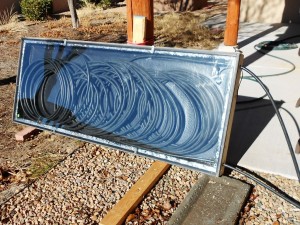
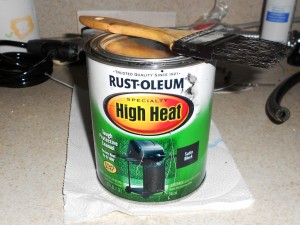

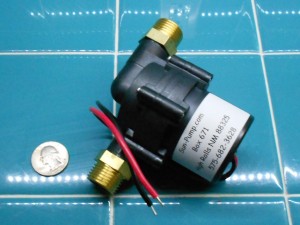

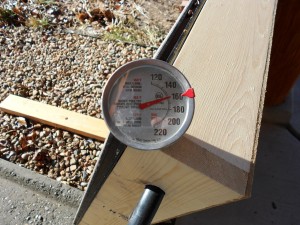
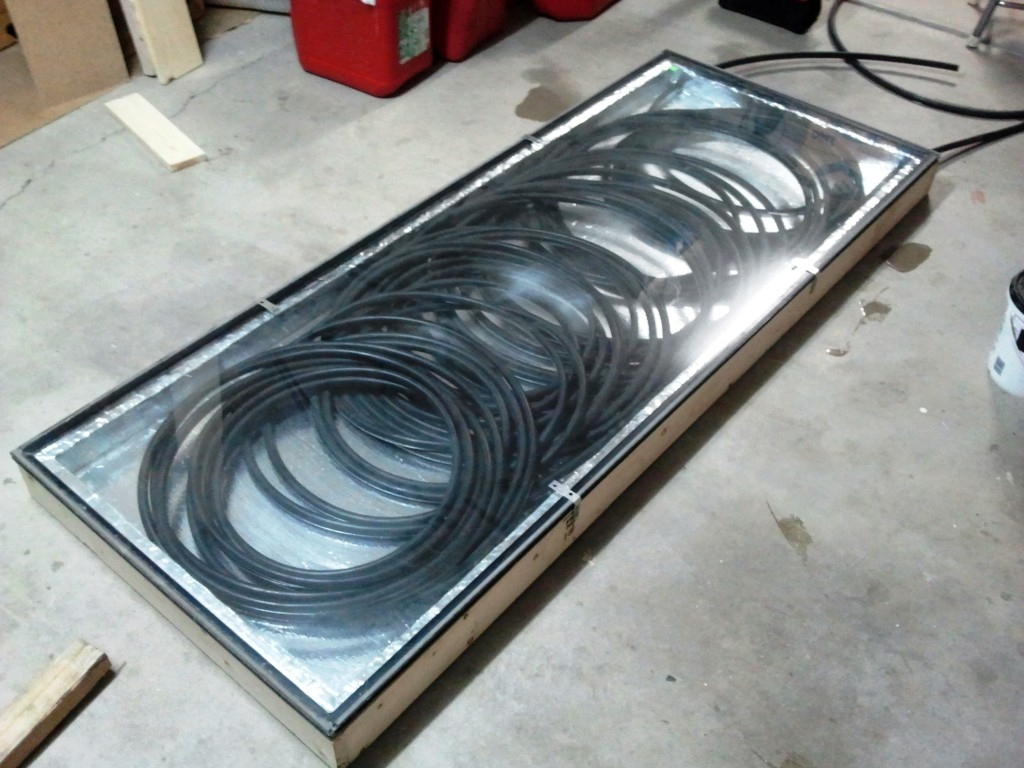
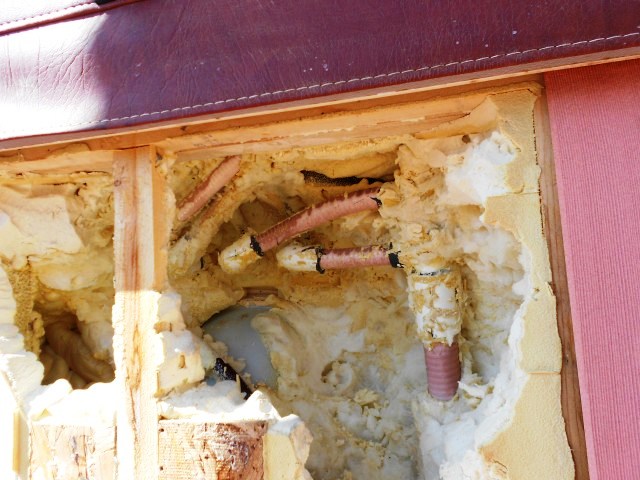

Dear sir
My name is Mohammed .Iam ph.D student , My research about flat plate solar collector. I need product(rust-oleum -specialty high heat black paint), My question , can I used this product to coat the absorber copper plate , If yes can you help me about what absorbitivity and emissivity for this product.
Thank you very much
Mohammed
Mohammad….this is a simple heat box design. The black paint is simply a heat absorbing resource to help amplify the effect of exchanging the cool water entering the black box (filled with coils of dark plastic tubing). In your design where you are describing how to make a solar conductive plate from copper…..you must scorch the copper plate with something like an acetylene torch. Where it gets all sooty…..that process preps the copper for solar conductivity. It is a published process and you can find it via web research.
How much pex is in that box? 500′? do you think 1/2″ drip tubing would work?
Hi Christian, I’m not exactly sure. I would guess that I used about 100′. Yes, I think nearly anything that will hold up to the heat and absorb it will work. The problem that I ran into was a lack of durability. The tubing I used would spring a leak from time to time and when really hot, would kink and twist. Definitely not ideal.